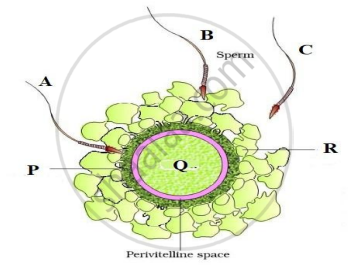Advertisements
Advertisements
Question
The figure given below shows 3 sperms A, B and C.
- Which one of the three sperms will gain entry into the ovum?
- Describe the associated changes induced by it on P and Q.

Ovum surrounded by few sperms
Solution
- Sperm A
- In the figure given, Sperm ‘A' has come in contact with the zona pellucida layer (P) of the ovum (Q), which will induce changes in the membrane that will block the entry of additional sperms (B and C). Thus, it ensures that only one sperm can fertilise the ovum.
The secretions of the acrosome of sperm A will help it to enter into the cytoplasm of the ovum (Q) through the zona pellucid (P) and the plasma membrane, this will induce the completion of the meiotic division of the secondary oocyte (Q).
The second meiotic division in Q being unequal will result in the formation of a second polar body and a haploid ovum. Then, the haploid nucleus of sperm ‘A’ and that of the ovum (Q) will fuse together to form a diploid zygote.
APPEARS IN
RELATED QUESTIONS
Name the stage of human embryo at which it gets implanted.
Where does fertilization occur in humans? Explain the events that occur during this process.
Name the hormones secreted and write their functions : during Follicular phase and parturition.
Name the stages in a human female where Corpus luteum and placenta co-exist.
Explain the process of implantation.
Match the following and choose the correct options:
| A. | Trophoblast | i. | Embedding of blastocyst in the endome |
| B. | Cleavage | ii. | Group of cells that would differentiate as embryo |
| C. | Inner cell mass | iii. | Outer layer of blastocyst attached to the endometrium |
| D. | Implantation | iv. | Mitonic division of zygote |
Test-tube baby means a baby born when ______.
A change in the amount of yolk and its distribution in the egg will affect ______.
The sperms undergo physiological maturation, acquiring increased motility and fertilising capacity in ______.
The finger-like projections that appear on the trophoblast following implantation, are called chorionic villi.
